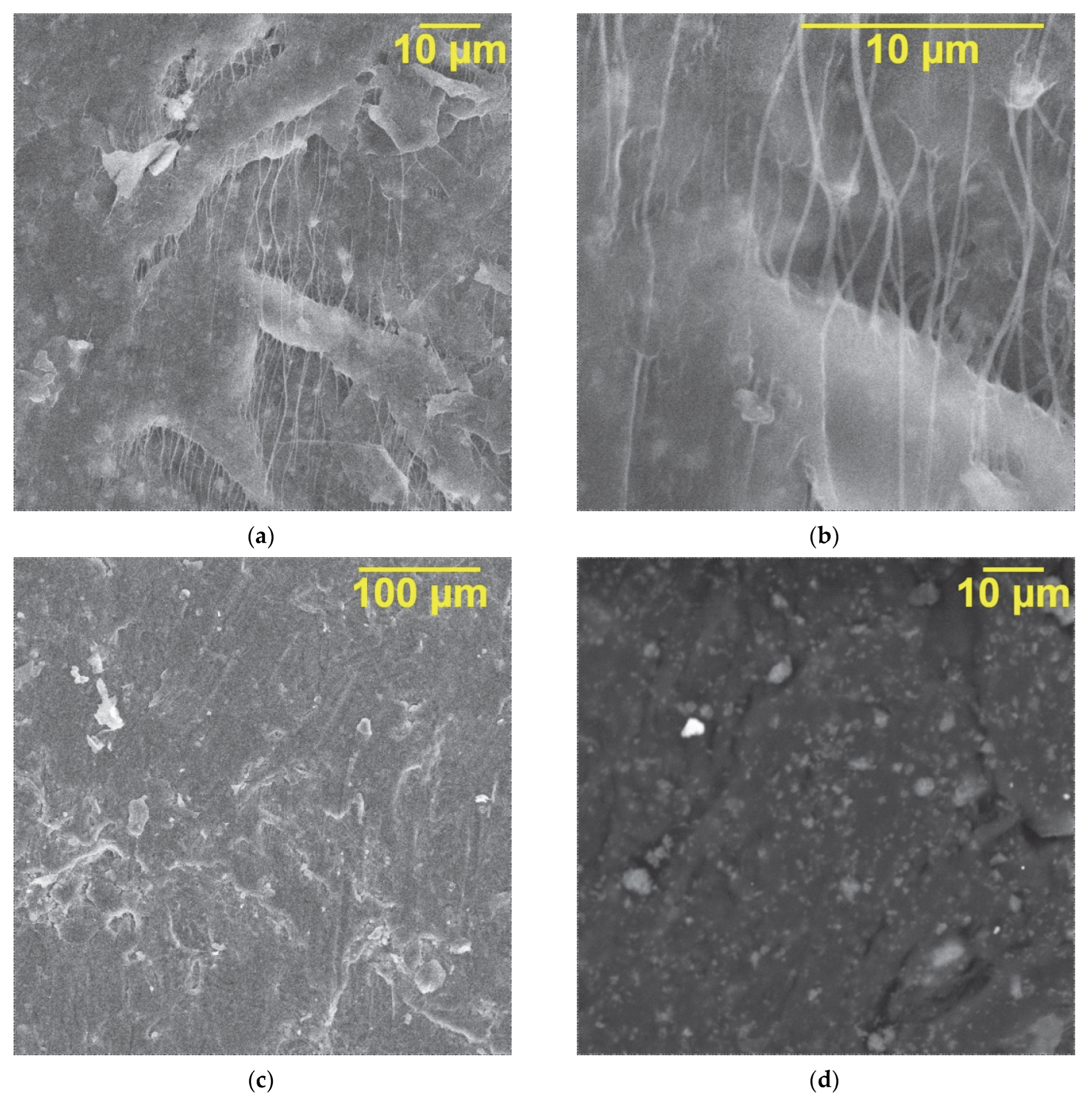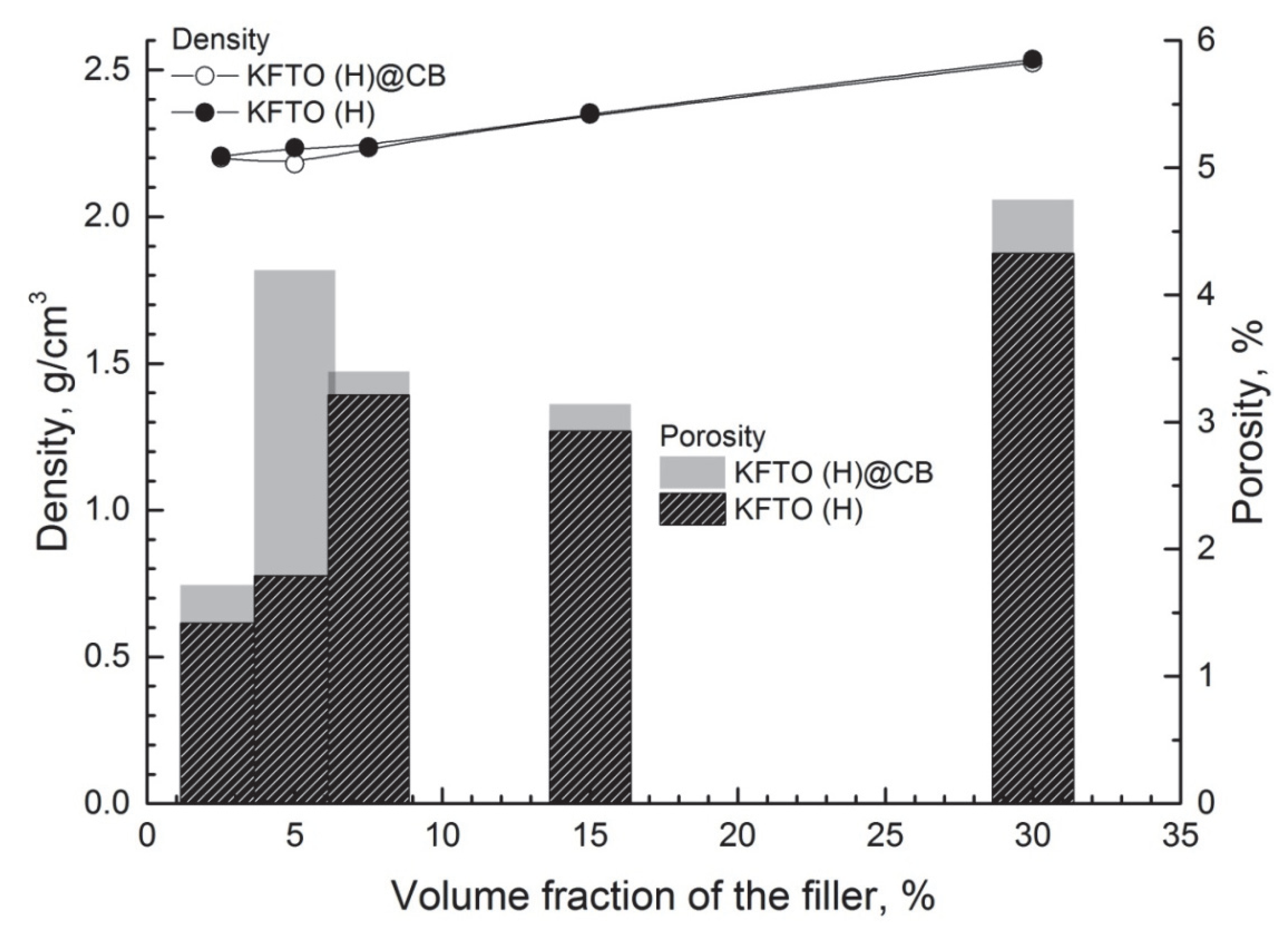Carbon Modification of K1.6Fe1.6Ti6.4O16 Nanoparticles to Optimize the Dielectric Properties of PTFE-Based Composites
Abstract
:1. Introduction
2. Materials and Methods
2.1. KFTO Synthesis
2.2. PTFE/KFTO(H) Composites Producing
2.3. Characteristics Methods
3. Results and Discussion
4. Conclusions
Author Contributions
Funding
Institutional Review Board Statement
Informed Consent Statement
Data Availability Statement
Acknowledgments
Conflicts of Interest
References
- Kessler, M.R. Polymer matrix composites: A perspective for a special issue of polymer reviews. Polym. Rev. 2012, 52, 229–233. [Google Scholar] [CrossRef]
- Dang, Z.M.; Yuan, J.K.; Zha, J.W.; Zhou, T.; Li, S.T.; Hu, G.H. Fundamentals, processes and applications of high-permittivity polymer–matrix composites. Prog. Mater. Sci. 2012, 57, 660–723. [Google Scholar] [CrossRef]
- Sinha, A.K.; Narang, H.K.; Bhattacharya, S. Mechanical properties of hybrid polymer composites: A review. J. Braz. Soc. Mech. Sci. 2020, 42, 1–13. [Google Scholar] [CrossRef]
- Zhang, L.; Deng, H.; Fu, Q. Recent progress on thermal conductive and electrical insulating polymer composites. Compos. Commun. 2018, 8, 74–82. [Google Scholar] [CrossRef]
- Vahedy, V. Polymer insulated high voltage cables. IEEE Electr. Insul. Mag. 2006, 22, 13–18. [Google Scholar] [CrossRef]
- Chen, C.; Wang, L.; Liu, X.; Yang, W.; Lin, J.; Chen, G.; Yang, X. K0.5Na0.5NbO3-SrTiO3/PVDF polymer composite film with low remnant polarization and high discharge energy storage density. Polymers 2019, 11, 310. [Google Scholar] [CrossRef]
- Cui, X.; Guo, J.; Araby, S.; Abbassi, F.; Zhang, C.; Diaby, A.L.; Meng, Q. Porous polyvinyl alcohol/graphene oxide composite film for strain sensing and energy-storage applications. Nanotechnology 2022, 33, 415701. [Google Scholar] [CrossRef]
- Barber, P.; Balasubramanian, S.; Anguchamy, Y.; Gong, S.; Wibowo, A.; Gao, H.; Ploehn, H.J.; Zur Loye, H.C. Polymer composite and nanocomposite dielectric materials for pulse power energy storage. Materials 2009, 2, 1697–1733. [Google Scholar] [CrossRef]
- Nelson, J.K. Dielectric Polymer Nanocomposites; Springer: New York, NY, USA, 2010; pp. 1–285. [Google Scholar]
- Sarkar, S.; Guibal, E.; Quignard, F.; SenGupta, A.K. Polymer-supported metals and metal oxide nanoparticles: Synthesis, characterization, and applications. J. Nanopart. Res. 2012, 14, 1–24. [Google Scholar] [CrossRef]
- Mohd, N.N.; Asyraf, M.M.; Khalina, A.; Abdullah, N.; Sabaruddin, F.A.; Kamarudin, S.H.; So’bah, A.; Annie, M.M.; Lee, C.L.; Aisyah, H.A.; et al. Fabrication, functionalization, and application of carbon nanotube-reinforced polymer composite: An overview. Polymer 2021, 13, 1047. [Google Scholar] [CrossRef]
- Su, J.; Zhang, J. Recent development on modification of synthesized barium titanate (BaTiO3) and polymer/BaTiO3 dielectric composites. J. Mater. Sci. Mater. Electron. 2019, 30, 1957–1975. [Google Scholar] [CrossRef]
- Yao, L.; Pan, Z.; Zhai, J.; Zhang, G.; Liu, Z.; Liu, Y. High-energy-density with polymer nanocomposites containing of SrTiO3 nanofibers for capacitor application. Compos. Part A Appl. Sci. Manuf. 2018, 109, 48–54. [Google Scholar] [CrossRef]
- He, Z. Simultaneously High Dielectric Constant and Breakdown Strength in CaCu3Ti4O12-Filled Polymer Composites. J. Electron. Mater. 2022, 51, 4521–4528. [Google Scholar] [CrossRef]
- Chiang, C.K.; Popielarz, R. Polymer composites with high dielectric constant. Ferroelectrics 2002, 275, 1–9. [Google Scholar] [CrossRef]
- Arbatti, M.; Shan, X.; Cheng, Z.Y. Ceramic–polymer composites with high dielectric constant. Adv. Mater. 2007, 19, 1369–1372. [Google Scholar] [CrossRef]
- Zhang, L.; Shan, X.; Bass, P.; Tong, Y.; Rolin, T.D.; Hill, C.W.; Brewer, J.C.; Tucker, D.S.; Cheng, Z.Y. Process and microstructure to achieve ultra-high dielectric constant in ceramic-polymer composites. Sci. Rep. 2016, 6, 1–10. [Google Scholar] [CrossRef] [PubMed]
- Kim, H.; Johnson, J.; Chavez, L.A.; Rosales, C.A.G.; Tseng, T.L.B.; Lin, Y. Enhanced dielectric properties of three phase dielectric MWCNTs/BaTiO3/PVDF nanocomposites for energy storage using fused deposition modeling 3D printing. Ceram. Int. 2018, 44, 9037–9044. [Google Scholar] [CrossRef]
- Luo, C.; Wang, Y.; Li, P. Lead-Free Barium Titanate/Graphene Oxide/PDMS Three-Phase Composite Piezoelectric Nanogenerator. Acta Electon. Sinica. 2022, TM282, 1–7. [Google Scholar]
- Muduli, S.P.; Parida, S.; Behura, S.K.; Rajput, S.; Rout, S.K.; Sareen, S. Synergistic effect of graphene on dielectric and piezoelectric characteristic of PVDF-(BZT-BCT) composite for energy harvesting applications. Polym. Adv. Technol. 2022, 33, 3628–3642. [Google Scholar] [CrossRef]
- Yang, C.; Song, S.; Chen, F.; Chen, N. Fabrication of PVDF/BaTiO3/CNT Piezoelectric Energy Harvesters with Bionic Balsa Wood Structures through 3D Printing and Supercritical Carbon Dioxide Foaming. ACS Appl. Mater. Interfaces. 2021, 13, 41723–41734. [Google Scholar] [CrossRef]
- Zhou, Z.; Zhang, Z.; Zhang, Q.; Yang, H.; Zhu, Y.; Wang, Y.; Chen, L. Controllable Core–Shell BaTiO3@ Carbon Nanoparticle-Enabled P (VDF-TrFE) Composites: A Cost-Effective Approach to High-Performance Piezoelectric Nanogenerators. ACS Appl. Mater. Interfaces. 2019, 12, 1567–1576. [Google Scholar] [CrossRef] [PubMed]
- Feng, S.; Zhang, H.; He, D.; Xu, Y.; Zhang, A.; Liu, Y.; Bai, J. Synergistic effects of BaTiO3/multiwall carbon nanotube as fillers on the electrical performance of triboelectric nanogenerator based on polydimethylsiloxane composite films. Energy Technol. 2019, 7, 1900101. [Google Scholar] [CrossRef]
- Gorshkov, N.; Vikulova, M.; Gorbunov, M.; Mikhailova, D.; Burmistrov, I.; Kiselev, N.; Artyukhov, D.; Gorokhovsky, A. Synthesis of the hollandite-like copper doped potassium titanate high-k ceramics. Ceram. Int. 2021, 47, 5721–5729. [Google Scholar] [CrossRef]
- Hassan, Q.U.; Yang, D.; Zhou, J.P.; Lei, Y.X.; Wang, J.Z.; Awan, S.U. Novel single-crystal hollandite K1.46Fe0.8Ti7.2O16 microrods: Synthesis, double absorption, and magnetism. Inorg. Chem. 2018, 57, 15187–15197. [Google Scholar] [CrossRef] [PubMed]
- Besprozvannykh, N.V.; Sinel’shchikova, O.Y.; Morozov, N.A.; Kuchaeva, S.K.; Postnov, A.Y. Synthesis and Physicochemical Properties of Complex Oxides K2MexTi8–xO16 (Me = Mg, Ni, Al) of Hollandite Structure. Russ. J. Appl. Chem. 2020, 93, 1132–1138. [Google Scholar] [CrossRef]
- Tsyganov, A.R.; Gorokhovsky, A.V.; Vikulova, M.A.; Artyukhov, D.I.; Zakharievich, D.A.; Saunina, S.I.; Gorshkov, N.V. Synthesis and dielectric properties of K1.6Fe1.6Ti6.4O16 ceramics produced by the Pechini method. Adv. Mater. Technol. 2022, 7, 68–77. [Google Scholar] [CrossRef]
- Gorshkov, N.; Goffman, V.; Vikulova, M.; Burmistrov, I.; Sleptsov, V.; Gorokhovsky, A. Polytetrafluorethylene-based high-k composites with low dielectric loss filled with priderite (K1.46Ti7.2Fe0.8O16). J. Appl. Polym. Sci. 2020, 137, 48762. [Google Scholar] [CrossRef]
- Vikulova, M.; Tsyganov, A.; Bainyashev, A.; Artyukhov, D.; Gorokhovsky, A.; Muratov, D.; Gorshkov, N. Dielectric properties of PMMA/KCTO (H) composites for electronics components. J. Appl. Polym. Sci. 2021, 138, 51168. [Google Scholar] [CrossRef]
- Vikulova, M.; Nikityuk, T.; Artyukhov, D.; Tsyganov, A.; Bainyashev, A.; Burmistrov, I.; Gorshkov, N. High-k Three-Phase Epoxy/K1.6(Ni0.8Ti7.2)O16/CNT Composites with Synergetic Effect. Polymer 2022, 14, 448. [Google Scholar] [CrossRef]
- Tsai, C.M.; Song, C.-G.; Hung, Y.-C.; Jeong, Y.-G.; Oh, S.H.; Jeong, J.H.; Kim, H.; Huh, H.; Yoon, J.-W.; Sigmund, W. Carbon induced phase transformation in electrospun TiO2/multiwall carbon nanotube nanofibers. Ceram. Int. 2017, 43, 3761–3768. [Google Scholar] [CrossRef]
- Moetakef, P.; Larson, A.M.; Hodges, B.C.; Zavalij, P.; Gaskell, K.J.; Piccoli, P.M.; Rodriguez, E.E. Synthesis and crystal chemistry of microporous titanates Kx(Ti, M)8O16 where M= Sc–Ni. J. Solid State Chem. 2014, 220, 45–53. [Google Scholar] [CrossRef]
- Piwowarczyk, J.; Jędrzejewski, R.; Moszyński, D.; Kwiatkowski, K.; Niemczyk, A.; Baranowska, J. XPS and FTIR studies of polytetrafluoroethylene thin films obtained by physical methods. Polymer 2019, 11, 1629. [Google Scholar] [CrossRef] [PubMed]
- Gorshkov, N.V.; Goffman, V.G.; Vikulova, M.A.; Burmistrov, I.N.; Kovnev, A.V.; Gorokhovsky, A.V. Dielectric properties of the polymer–matrix composites based on the system of Co-modified potassium titanate–polytetrafluorethylene. J. Compos. Mater. 2018, 52, 135–144. [Google Scholar] [CrossRef]
- Liu, Y.; Li, L.; Shi, J.; Han, R.; Wu, P.; Yue, X.; Zhou, Z.; Chen, G.-X.; Li, Q. High dielectric constant composites controlled by a strontium titanate barrier layer on carbon nanotubes towards embedded passive devices. Chem. Eng. J. 2019, 373, 642–650. [Google Scholar] [CrossRef]







Publisher’s Note: MDPI stays neutral with regard to jurisdictional claims in published maps and institutional affiliations. |
© 2022 by the authors. Licensee MDPI, Basel, Switzerland. This article is an open access article distributed under the terms and conditions of the Creative Commons Attribution (CC BY) license (https://creativecommons.org/licenses/by/4.0/).
Share and Cite
Tsyganov, A.; Vikulova, M.; Artyukhov, D.; Bainyashev, A.; Goffman, V.; Gorokhovsky, A.; Gorshkov, N. Carbon Modification of K1.6Fe1.6Ti6.4O16 Nanoparticles to Optimize the Dielectric Properties of PTFE-Based Composites. Polymers 2022, 14, 4010. https://doi.org/10.3390/polym14194010
Tsyganov A, Vikulova M, Artyukhov D, Bainyashev A, Goffman V, Gorokhovsky A, Gorshkov N. Carbon Modification of K1.6Fe1.6Ti6.4O16 Nanoparticles to Optimize the Dielectric Properties of PTFE-Based Composites. Polymers. 2022; 14(19):4010. https://doi.org/10.3390/polym14194010
Chicago/Turabian StyleTsyganov, Alexey, Maria Vikulova, Denis Artyukhov, Alexey Bainyashev, Vladimir Goffman, Alexander Gorokhovsky, and Nikolay Gorshkov. 2022. "Carbon Modification of K1.6Fe1.6Ti6.4O16 Nanoparticles to Optimize the Dielectric Properties of PTFE-Based Composites" Polymers 14, no. 19: 4010. https://doi.org/10.3390/polym14194010








